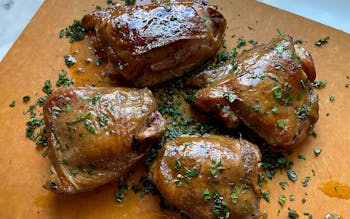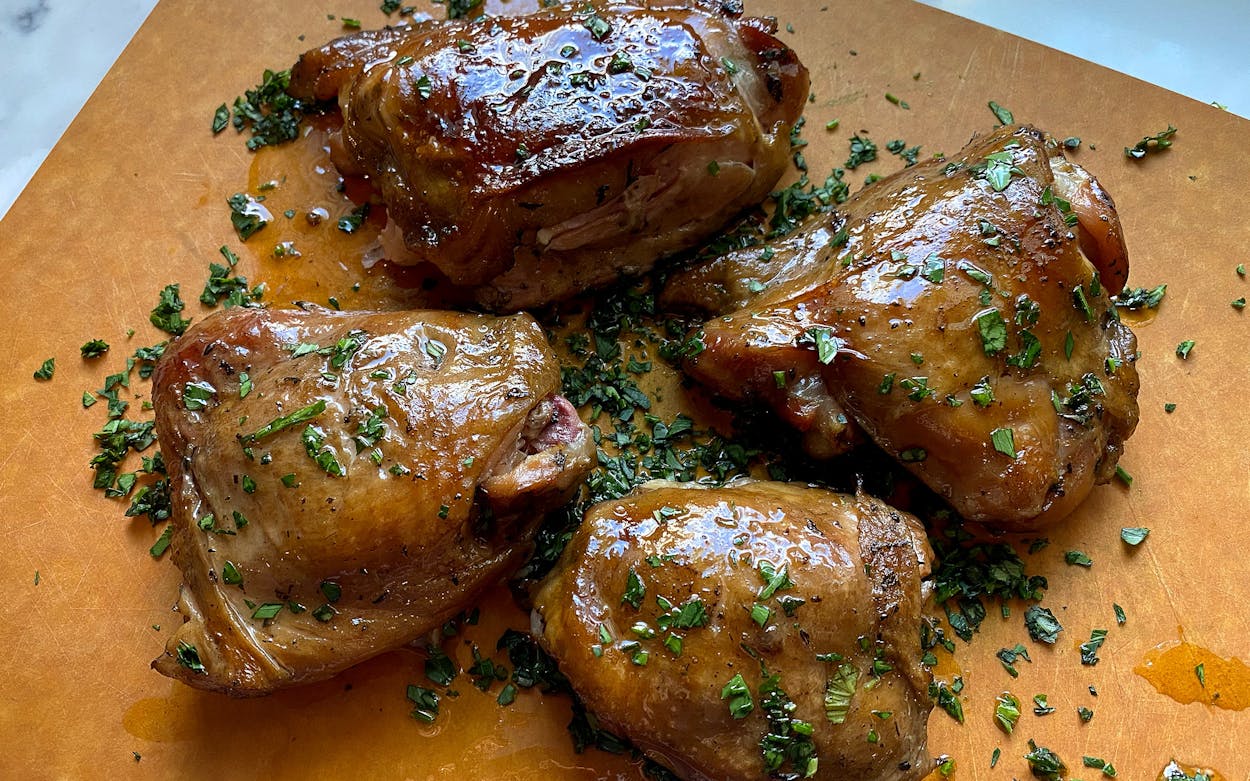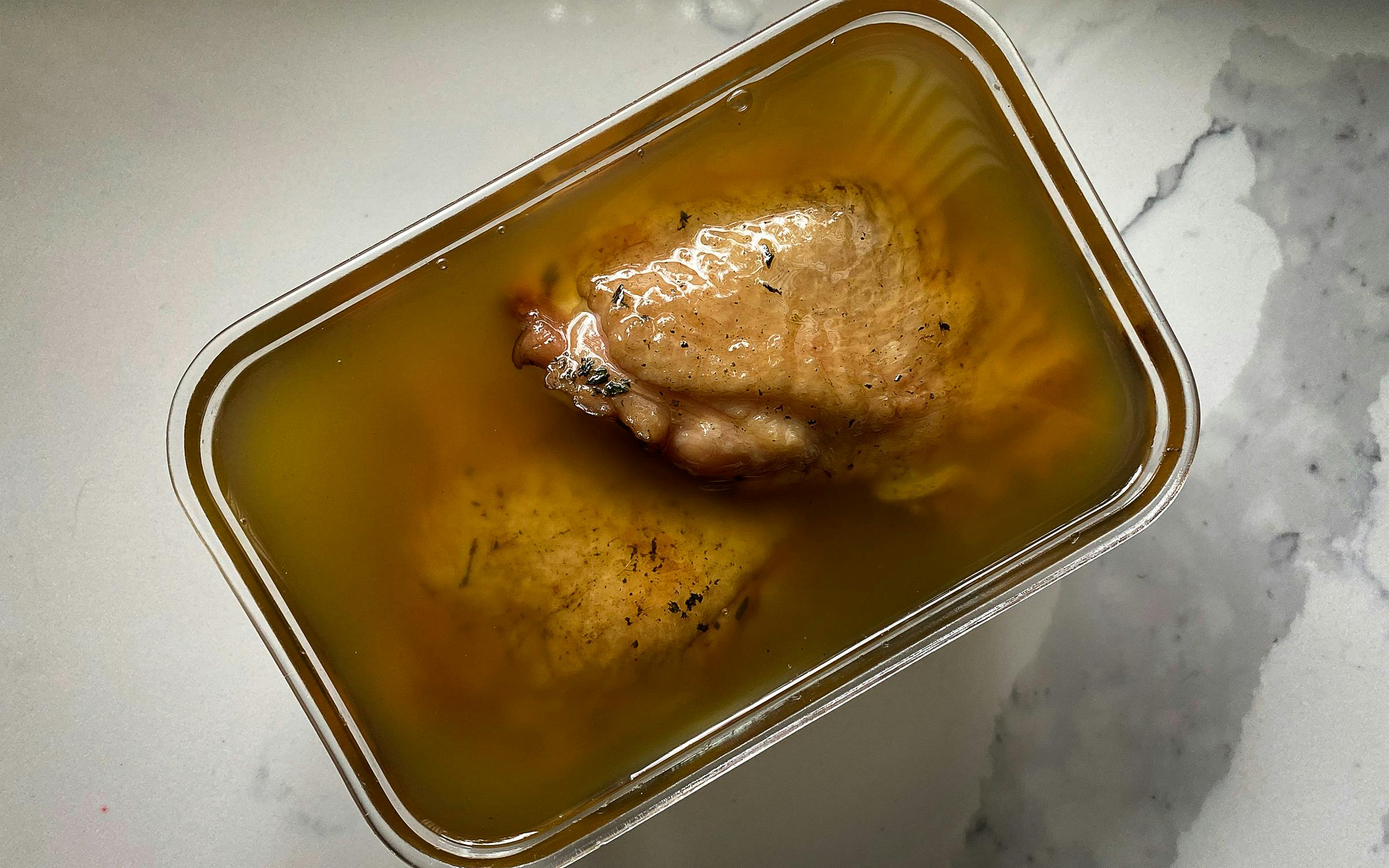It was an outrageously expensive A5 Wagyu brisket that lured me to Austin. The team at LeRoy and Lewis had plans to smoke it, and they offered me a taste. It was the height of barbecue decadence, but that day in November, owner Evan LeRoy also served a more humble dish that has proved just as memorable. He and his crew prepared rabbit carnitas, and my portion was a leg quarter, which looked like it came from a skinny chicken. The meat had been smoked, then submerged in warm pork fat for hours. After an overnight chill, the rabbit quarters were reheated over direct heat. It was incredibly tender and juicy, and it got me wondering how to get more pitmasters to embrace a similar cooking method: confit.
Yes, it’s a fancy-sounding French word, but confit simply means to cook meat slowly while it’s submerged in its own fat. It’s also perfectly acceptable to use another animal fat or other oils. For most pitmasters, finding surplus animal fat isn’t a challenge. You can only use so much brisket fat in sausages, so grind the rest and melt it in the smoker for a beef tallow supply that’s perfect for confit. For LeRoy, it’s a different protein that provides the abundant flavor. “We’re just always looking for ways to use pork fat,” he says.
With confit, you’ll never again serve dry meat. “The meat is super juicy,” LeRoy says. “I mean, it’s bathed in fat.” The more important advantage of confit is the ability to take cuts that are challenging to hold in a warmer for long periods, like skin-on chicken, and instead cook them to order. The method can also remove the day-to-day guesswork of just how much meat to cook.
Confit is a cooking method, sure, but it’s really a preservation method. Before refrigeration, meat submerged in fat could be safely stored in crocks for weeks or even months. A restaurant serving duck confit, probably the best-known version, does most of the cooking one or more days ahead, then keeps it chilled underneath all that fat. The last 5 percent of the process happens once the chilled meat is retrieved from under the fat and reheated quickly over a grill or under a broiler, just after it’s ordered. This ensures hot, crispy skin and juicy meat beneath it. The same could work for chicken, and I wondered how it would combine the flavor of smoked chicken with the unique juiciness of the confit method.
At home, I seasoned some bone-in, skin-on chicken thighs with kosher salt, black pepper, garlic powder, and fresh thyme the day before I planned to smoke them. They sat overnight, covered, in the refrigerator, and I smoked them the next day. I prefer a hotter smoker temperature when smoking chicken, and they took just under ninety minutes at 300 degrees to reach an internal temperature of 155 degrees.
Inside, I had my oven set to 225 and a vat of duck fat on the counter. Duck fat is probably the most bougie option for a confit fat, but I had some left over from duck confit that I made a while back. (Full disclosure: “a while back” means a few Christmases ago, and the fat sat in the coldest part of my fridge for three years. Fat will tell you when it’s bad by putting off a rancid smell, and this one still smelled great. I guess that further shows the preservation value of well-strained animal fats.) LeRoy said he uses both pork and beef fat at the restaurant, but they won’t be liquid at room temp like duck fat, so you’ll need to heat them up a bit to pour them over the chicken thighs.
After arranging the chicken in a Pyrex dish, I poured the fat over it, then covered the dish with foil and its glass lid. LeRoy uses two layers of plastic wrap (don’t worry, the oven temperature is low) and a layer of foil to ensure a tight seal. My chicken thighs went into the oven for five hours, then I let the dish cool and chilled it overnight in the refrigerator. I broiled them the next day, both to warm them back up and to crisp the skin. A friend told me they were the best chicken thighs he’d ever eaten, and I tried to be modest for a half minute before agreeing with him.
One note: Be careful when crisping the skin. My brand-new oven saw its first legitimate fire when all that cold duck fat melted off onto the pan and splattered up into the broiler burner. I pulled the pan out steadily and swiftly and saved the thighs, while also teaching my kids an important lesson when their first instinct was to throw water on the fire. Never throw water onto flaming duck fat or any other kind of grease fire.
The smoke flavor plus the texture of confit chicken was an incredible combination. Now, I’m not suggesting you put your entire barbecue menu through the confit method, although that is how LeRoy treats all of the smoked beef cheeks served at LeRoy and Lewis. “We’re definitely going to mess around with chickens done this way,” LeRoy told me. “It might be a really good thing for events, whenever they come back,” he added. For any pitmaster sick of serving flabby chicken halves after they sat in the warmer for a couple hours, this might be a way to serve hot, crisp chicken every time. It’s also a good way to impress your friends at home if you have some lard, tallow (like the smoked fats sold by Feges BBQ in Houston), or duck fay lying around.

Smoked Confit Chicken Thighs
Equipment
- 1 smoker
Ingredients
- 4 bone-in, skin-on chicken thighs
- 1 tablespoon kosher salt
- 1 teaspoon ground black pepper
- 1 teaspoon garlic powder
- 1 tablespoon fresh thyme leaves
- 2 pounds animal fat*, preferably pork lard, beef tallow, duck fat, schmaltz, or a combination of those. (Heck, throw in some rendered bacon fat, and let me know how it turns out.)
Directions
- Season the thighs the night before smoking. I used a mortar and pestle to grind the salt, pepper, garlic powder, and fresh thyme together, but chopping the thyme finely should suffice. After seasoning, place the thighs in a covered container in the refrigerator overnight.
- Smoke the following day at 300 degrees for about 60 to 90 minutes, until the internal temperature reaches 160 degrees. While the thighs are smoking, preheat an oven to 225 degrees.
- Place the smoked thighs in an oven-ready container. The tighter they fit into the pan and the more evenly the thighs are laid out, the less fat you’ll need to cover them. If there’s a lot of empty space in the pan once you’ve laid out the thighs, choose a smaller pan. Now pour on the fat, and make sure the meat is completely covered. Cover the pan tightly and place into a 225-degree oven (or let them ride next to your briskets in the smoker) for the next 5 hours.
- You can chill them for use the following day, or finish the preparation now for immediate consumption. To crisp the skin, place the thighs skin side up under a broiler, or skin side down in a hot cast-iron pan or on a hot grill. Watch them carefully, and be sure not to burn the skin. This should take no more than 5 minutes if they were still warm, or 10 minutes if they’ve been chilled. Enjoy.

















